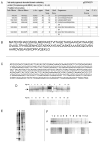Identification of a sporozoite-specific antigen from Toxoplasma gondii
- PMID: 21506817
- PMCID: PMC3684278
- DOI: 10.1645/GE-2782.1
Identification of a sporozoite-specific antigen from Toxoplasma gondii
Abstract
Reduction of risk for human and food animal infection with Toxoplasma gondii is hampered by the lack of epidemiological data documenting the predominant routes of infection (oocyst vs. tissue cyst consumption) in horizontally transmitted toxoplasmosis. Existing serological assays can determine previous exposure to the parasite, but not the route of infection. We have used difference gel electrophoresis, in combination with tandem mass spectroscopy and Western blot, to identify a sporozoite-specific protein (T. gondii embryogenesis-related protein [TgERP]), which elicited antibody and differentiated oocyst- versus tissue cyst-induced infection in pigs and mice. The recombinant protein was selected from a cDNA library constructed from T. gondii sporozoites; this protein was used in Western blots and probed with sera from T. gondii -infected humans. Serum antibody to TgERP was detected in humans within 6-8 mo of initial oocyst-acquired infection. Of 163 individuals in the acute stage of infection (anti- T. gondii IgM detected in sera, or < 30 in the IgG avidity test), 103 (63.2%) had detectable antibodies that reacted with TgERP. Of 176 individuals with unknown infection route and in the chronic stage of infection (no anti- T. gondii IgM detected in sera, or > 30 in the IgG avidity test), antibody to TgERP was detected in 31 (17.6%). None of the 132 uninfected individuals tested had detectable antibody to TgERP. These data suggest that TgERP may be useful in detecting exposure to sporozoites in early T. gondii infection and implicates oocysts as the agent of infection.
Figures




References
-
- Appleford PJ, Smith JE. Strain and stage specific variation in Toxoplasma gondii antigen. International Journal of Parasitology. 2000;30:1187–1191. - PubMed
-
- Aramini JJ, Stephen C, Dubey JP. Toxoplasma gondii in Vancouver Island cougars (Felis concolor vancouverensis): Serology and oocyst shedding. Journal of Parasitology. 1998;84:438–440. - PubMed
-
- Bahia-Oliveira LMG, Wilken de Abreu AM, Azevedo-Silva J, Oréfice F. Toxoplasmosis in southeastern Brazil: an alarming situation of highly endemic acquired and congenital infection. International Journal of Parasitology. 2001;31:133–136.
Publication types
MeSH terms
Substances
Grants and funding
LinkOut - more resources
Full Text Sources
Other Literature Sources
Medical

